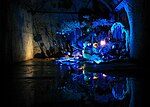The Old Vic

The Old Vic is a 1,000-seat, not-for-profit producing theatre in Waterloo, London, England. Established in 1818 as the Royal Coburg Theatre, and renamed in 1833 the Royal Victoria Theatre. In 1871 it was rebuilt and reopened as the Royal Victoria Palace. It was taken over by Emma Cons in 1880 and formally named the Royal Victoria Hall, although by that time it was already known as the "Old Vic". In 1898, a niece of Cons, Lilian Baylis, assumed management and began a series of Shakespeare productions in 1914. The building was damaged in 1940 during air raids and it became a Grade II* listed building in 1951 after it reopened.The Old Vic is the crucible of many of the performing arts companies and theatres in London today. It was the name of a repertory company that was based at the theatre and formed (along with the Chichester Festival Theatre) the core of the National Theatre of Great Britain on its formation in 1963, under Laurence Olivier. The National Theatre remained at the Old Vic until new premises were constructed on the South Bank, opening in 1976. The Old Vic then became the home of Prospect Theatre Company, at that time a highly successful touring company which staged such acclaimed productions as Derek Jacobi's Hamlet. However, with the withdrawal of funding for the company by the Arts Council of Great Britain in 1980 for breaching its touring obligations, Prospect disbanded in 1981. The theatre underwent complete refurbishment in 1985. In 2003, Kevin Spacey was appointed artistic director, which received considerable media attention. Spacey served as artistic director until 2015; two years after he stepped down, he was accused of sexually harassing and assaulting several students. In 2015, Matthew Warchus succeeded Spacey as artistic director.
Excerpt from the Wikipedia article The Old Vic (License: CC BY-SA 3.0, Authors, Images).The Old Vic
The Cut, London Lambeth (London Borough of Lambeth)
Geographical coordinates (GPS) Address Website External links Nearby Places Show on map
Geographical coordinates (GPS)
| Latitude | Longitude |
|---|---|
| N 51.5022 ° | E -0.1096 ° |
Address
The Old Vic
The Cut 103
SE1 8NB London, Lambeth (London Borough of Lambeth)
England, United Kingdom
Open on Google Maps










